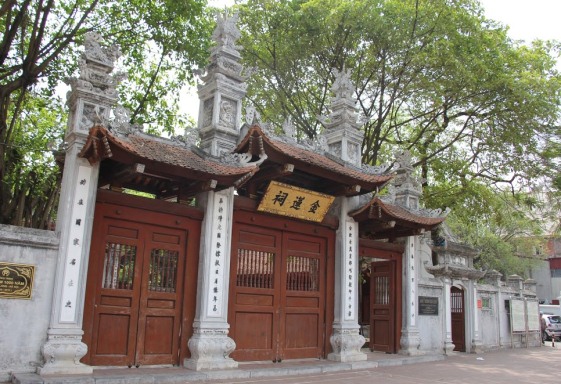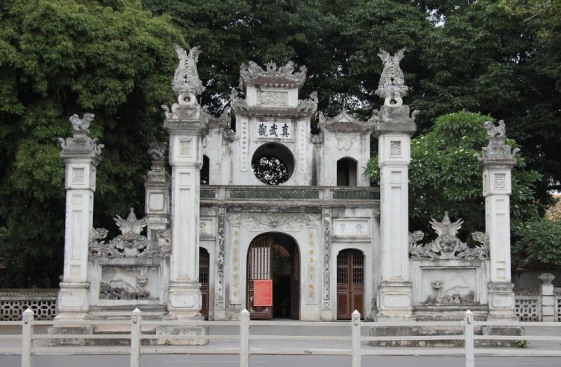Thang Long-Tu Tran: Timeless sentinels of Ha Noi’s thousand-year history
VGP - Thang Long's four guardian god temples (Thang Long-Tu Tran), standing as timeless sentinels of Ha Noi’s thousand-year history, came into existence very early, associated with the founding of the Thang Long capital under the Ly dynasty in 1010.

Bach Ma temple
They are places dedicated to four deities who guarded the cardinal directions of the Thang Long citadel, protecting the ancient imperial capital-now Ha Noi-so that it would remain peaceful day and night.
The recognition of Thang Long Tu Tran as a special national relic in 2022 honors their extraordinary historical, cultural, architectural and artistic values.
Bach Ma temple
Located in the East, Bach Ma (White Horse) temple was first erected in 866 (now at No.76 Hang Buom Street). The temple is dedicated to Long Do, safeguarding the livelihood and well-being of residents in the capital and protecting the capital itself. It was later rebuilt during the Ly dynasty after 1010, making it the oldest temple among Thang Long Tu Tran.
Throughout the Ly, Tran and Le dynasties, with 52 kings ruling in the ancient Thang Long capital, Bach Ma temple witnessed the capital's vicissitudes. At present, Bach Ma temple still has the Nguyen dynasty's architectural style and preserves valuable artifacts, such as steles recording anecdotes and myths about the construction of the temple, rituals dedicated to Long Do deity as well as its restorations over more than a millennium.

Voi Phuc temple
Voi Phuc temple
Voi Phuc temple was built in Thu Le village to the west of the ancient Thang Long capital. Its name, which means prostrating elephants, derives from the two kneeling elephant statues standing at its entrance.
Constructed in 1065 by King Ly Thanh Tong to worship his son, Prince Linh Lang, who made great contributions to the resistance against the Song dynasty's invasion and sacrificed with courage. The temple later gained further reverence during the Tran dynasty, when the prince was believed to aid the royal troops in repelling two Mongol invasions.
The temple houses splendid gilded horizontal lacquered boards and parallel sentences in Han (ancient Chinese) characters, extolling the deity's virtue and sacredness. It was officially recognized as a national historical and cultural relic in 1962.

Kim Lien temple
Kim Lien temple
Kim Lien temple was first built during the Ly dynasty in Kim Hoa village (now Kim Lien ward). It is dedicated to Cao Son Dai Vuong (Cao Son deity), a guardian deity believed to protect the people against disasters and foreign enemies, maintaining peace and prosperity.
According to legend, Cao Son deity was a son of Lac Long Quan and Au Co, who are believed the ancestors of the Vietnamese nation, one of the 50 children who followed their mother to the mountains. Later, he chose to settle and cultivate the land in the village. After his passing, villagers built the temple in his honor.
Historical records at the temple indicate that King Ly Thai To ordered its reconstruction shortly after establishing the Thang Long capital in 1010, as a protective shrine in the South.
Despite historical upheavals, Kim Lien temple has been kept in its original state. It preserves valuable relics, including 33 royal decrees from the Le and Nguyen dynasties, and the stone stele Cao Son Dai Vuong Than Tu Bi Minh (inscription of the deeds of Cao Son deity) made in 1510. These treasures not only provide crucial historical records but also offer insights into calligraphy, linguistics and traditional Vietnamese art.
The temple was recognized as a national historical and cultural relic in 1990.

Quan Thanh temple
Quan Thanh temple
Nestled in the North, Quan Thanh temple was built in the early years of King Ly Thai To's reign, in the northeastern shore of the West Lake (now Quan Thanh ward). In 1823, King Minh Mang renamed it Tran Vu Quan (Tran Vu shrine), and in 1842, King Thieu Tri gave it its present name, Quan Thanh temple.
The temple is dedicated to Huyen Thien Tran Vu, the northern guardian deity believed to expel demons and evil spirits. At its center stands an imposing bronze statue of Huyen Thien Tran Vu deity with a height of 3.96 meters, 8-meter circumference and a weight of 4 tons.
This masterpiece reflects the exceptional bronze-casting skills of Vietnamese artisans of the past. The temple also preserves many relics and antiquities of various types and materials from different historical periods such as stone steles and royal decrees, the earliest of which dates back to 1770.
Quan Thanh temple was recognized as a national historical and cultural relic in 1962. In 2016, the bronze statue was further honored as a national treasure, affirming the temple's immense historical and artistic value./.

